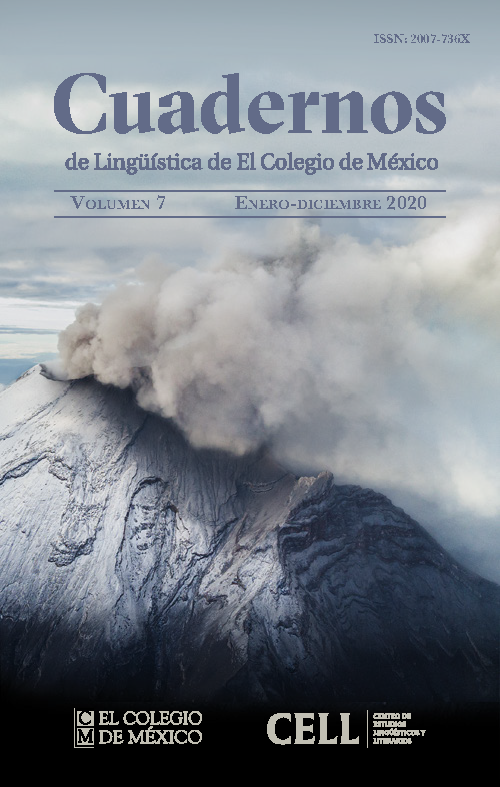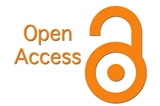Indigenous identity and the Mexican educational system: the case of a Chatino translation of the Mexican national anthem
DOI:
https://doi.org/10.24201/clecm.v7i0.155Keywords:
chatino, translation, educationAbstract
Translation of the Mexican national anthem into indigenous languages serves as a platform for the complex intersections between education, expression of indigenous identity, and Mexican nationalism, creating an indexical meaning that is negotiated and disputed in indigenous communities. Translating a coun‑ try’s anthem into an indigenous language raises further questions of semiotic techniques arising from a professed desire to integrate indigenous people into the larger Mexican society and which highlights language ideologies and power dynamics. Here, I describe the translation of the Mexican national anthem into the Chatino language of San Juan Quiahije, Oaxaca, Mexico. The text is provided in its entirety along with a comparative textual analysis of the translation. New cultural meanings that arise from the translation itself are examined, as well as the impact and implications of the performance of the national anthem in preschool and elementary schools. This case study exemplifies that in order to genuinely embrace indigenous languages in Mexico, the federal government must support the use of indigenous languages in public institutions, such as schools. Such projects will be most successful when led by indigenous people.
Downloads
References
Baronnet, Bruno. 2012. Autonomía y educación indígena: Las escuelas zapatistas de la Selva Lacandona de Chiapas, México. Quito: Abya‑Yala.
Bassnett, Susan. 2011. Reflections on translation. Bristol: Multilingual Matters.
Bourdieu, Pierre, & Thompson, John B. 1991. Language and symbolic power. Cambridge: Harvard University Press.
Brenzinger, Matthias. 2007. Language diversity endangered. Berlin: De Gruyter Mouton.
Campbell, Eric. 2013. The internal diversification and subgrouping of Chatino. International Journal of American Linguistics 79. 395–420.
Cruz, Emiliana. 2019. Swearing and cursing in San Juan Quiahije Chatino. Journal of Linguistic Anthropology 2. 181.
Cruz, Emiliana. 2018. Documenting landscape knowledge in eastern Chatino: narratives of fieldwork in San Juan Quiahije. Journal of Anthropological Linguistics. 59(2). 205–231.
Cruz, Emiliana & Anthony Woodbury. 2014. Collaboration in the context of teaching, scholarship, and language revitalization: experience from the Chatino language. Language Documentation & Conservation 8. 262–286.
Cruz, Emiliana. 2011. Phonology, tone and the functions of tone in San
Juan Quiahije Chatino. Austin: University of Texas. (Doctoral disser‑ tation).
Cruz, Hilaria. 2014. Linguistic poetics and rhetoric of eastern Chatino of San Juan Quiahije. Austin: University of Texas. (Doctoral dissertation).
Cruz, Hilaria. 2017. Prayers for the community: parallelism and performance in San Juan Quiahije eastern Chatino. Oral Tradition 31(2). 509–534.
Coronil, Fernando. 1996. Beyond occidentalism: toward nonimperial geohistorical categories. Cultural Anthropology 1. 51.
Davis, J.L. 2016. Language affiliation and ethnolinguistic identity in
Chickasaw language revitalization. Language and Communication 47. 100–111.
England, Nora. 2003. Mayan language revival and revitalization politics: linguists and linguistic ideologies. American Anthropologist 4. 733.
Falconi, Elizabeth. 2013. Storytelling, language shift, and revitalization
in a transborder community: Tell it in Zapotec! American Anthropologist 115(4). 622–636.
Faudree, Paja. 2015. Why X doesn’t always mark the spot: contested authenticity in mexican indigenous language politics. Semiotica: Journal of the International Association for Semiotic Studies/Revue De L’asso- citation Internationale de Sémiotique 203(1–4). 179–201.
Fuentes, Rocío. 2012. Indigenous‑mestizo interaction in Mexico. In Bratt Paulston, Christina; Kiesling, Scott F. & Rangel, Elizabeth
S. (eds.), Handbook of intercultural discourse and communication,
–363. Hoboken: Wiley.
García Deister, Vivette, & López‑Beltrán, Carlos. 2013. Genoteca indígena recopila ADN de mexicanos. El Universal, CDMX. (https://archivo.eluniversal.com.mx/ciencia/2013/genoteca‑indige‑ na‑adn‑mexicanos‑82420.html.)
Gómez Menjívar, Jennifer Carolina & Salmon, William Noel. 2018. Tropical tongues: language ideologies, endangerment, and minority lan- guages in Belize (Studies in Latin America Series). Chapel Hill: Insti‑
tute for the Study of the Americas at the University of North Carolina at Chapel Hill/ University of North Carolina Press.
Gramsci, Antonio, Hoare, Quintin, & Nowell‑Smith, Geoffrey. 1971. Selections from the prison notebooks of Antonio Gramsci. New York: International Publishers.
Grenoble, L.A. & Whaley, L.J. 1998. Endangered languages: language loss and community response. Cambridge: Cambridge University Press.
Habermas, Jürgen. 1991. The structural transformation of the public sphere: an inquiry into a category of bourgeois society. Cambridge: MIT
Press.
Hamel, Enrique Rainer, Erape Baltazar, Ana Elena, & Márquez Escamilla, Betzabé. 2018. La construcción de la identidad p’urhepecha a partir de la educación intercultural bilingüe propia. Trabalhos em Linguística Aplicada 57(3). 1377–1412.
Heath, Shirley Brice. 1972. Telling tongues: Language policy in Mexico,
colony to nation. Institute of International Studies, Columbia University. New York: Teachers College Press. [Published in Spanish as La política del lenguaje en México: de la colonia a la nación. Mexico: Instituto Nacional Indigenista/SEP]
Hernández Díaz, Jorge. 1987. El café amargo: Los procesos de diferenciación y cambio social entre los chatinos. Oaxaca: Universidad Autónoma Benito Juárez de Oaxaca/Instituto de Investigaciones Sociológicas.
Hidalgo, Margarita. 1994. Bilingual education, nationalism and ethnicity in Mexico: From theory to practice. Language Problems and Language Planning 18(3). 184–207.
Instituto Nacional de Lenguas Indígenas. 2008. Catálogo de lenguas indígenas nacionales. Mexico: Instituto Nacional de Lenguas Indígenas.
Instituto Nacional para la Evaluación de la Educación. 2006. La cali- dad de la educación básica en México. Informe anual 2006. México:INEE/SEP (http://www.inee.edu.mx/images/stories/Publicaciones/ Informes_institucionales/2006/Resumen_ejecutivo/Completo/ayer‑ hoymanana.pdf.)
Instituto de Estadística y Geografía. 2010.(http://cuentame.inegi.org. mx/hipertexto/todas_lenguas.htm.)
Kaltmeier, Olaf, & Rufer, Mario, (eds.) 2017. Entangled heritages: postcolonial perspectives on the uses of the past in Latin America. New York: Routledge.
Kaufman, Terrence. 2006. Otomanguean languages. In Brown, Keith (ed.), Encyclopedia of languages & linguistics, 2nd edition, 118–124. Oxford: Elsevier.
Keane, Webb. 1997. Signs of recognition: powers and hazards of representation in an Indonesian society. Berkeley: University of California Press.
Keane, Webb. 2003. Semiotics and the social analysis of material things. Language & Communication 23(3–4). 409–425.
Klein, Hilary. 2015. Compañeras: Zapatista women’s stories. New York: Seven Stories Press.
Ley General de Derechos Lingüísticos de los Pueblos Indígenas. 13 de marzo de 2003. Mexico: Diario Oficial de la Federación/SEGOB.
Lillehaugen, Brook Danielle. 2016. Why write in a language that (almost) no one can read? Twitter and the development of written literature.
Language Documentation and Conservation 10. 356–393.
López, Gerardo & Velasco, Sergio. 2000. Aportaciones indias a la educación. Ciudad de Mexico: Ediciones el Caballito/SEP.
Messing, Jacqueline. 2007. Multiple ideologies and competing discourses: language shift in Tlaxcala, Mexico. Language in Society 36(4). 555.
Miranda Juárez, Vanessa. 2017. Hermoseando el pasado glorioso: el análisis del discurso en la interpretación de una identidad nacional.
Revista Cuicuilco 24(70) 47–77.
Mora Bayo, Mariana. 2017. Kuxlejal politics: indigenous autonomy, race, and decolonizing research in Zapatista communities. Austin: University of Texas Press.
Montes, Ofelia. 1995. Maestros en zonas indígenas: Intermediarios culturales y/o políticos. Nueva Antropología 14(48). 83–94.
Muñoz Cruz, Héctor. 2006. Cambio sociolingüístico y experiencias
socioculturales desde discursos autobiográficos de hablantes de lenguas indígenas. Cuadernos Interculturales 4(7). 23–48
Muñoz Ramírez, Gloria; Carlsen, Laura, & Reyes Arias, Alejandro. 2008.
The fire and the word: a history of the Zapatista movement. San Francis‑ co: City Lights Books.
Nettle, Daniel & Romaine, Suzanne. 2007. Vanishing voices: the extinction of the world’s languages. New York: Oxford University Press.
Pineda, Luz Olivia. 1993. Caciques culturales: el caso de los maestros bilingües en los Altos de Chiapas. Puebla: Altres Costa‑Amic.
Rodriguez, Juan Luis. 2016. The national anthem in Warao: Semiotic ground and performative affordances of indigenous language texts in Venezuela. Journal of Linguistic Anthropology 26(3). 335–351.
Rogers, Chris, & Campbell, Lyle. 2011. Endangered languages. New York: Oxford University Press.
Joel Sherzer. 1987. A discourse‑centered approach to language and culture. American Anthropologist 89(2). 295.
Silverstein, Michael. 1996. Monoglot “standard” in America: standardization and metaphors of linguistic hegemony. In Brenneis, D. & Macaulay, R. K. S. (eds.) Matrix of language: contemporary linguistic anthropology 284–306. Boulder: Westview.
Simons, Gary & Lewis, Paul. 2013. The world’s languages in crisis: a 20‑year update. In Mihas, Elena; Perley, Bernard; Rei‑Doval, Gabriel & Wheatley, Kathleen (eds.) Responses to language endangerment 3–19. Amsterdam: John Benjamins.
Stoll, David. 1982. The Summer Institute of Linguistics and indigenous movements. Latin American Perspectives 9(2). 84–99.
Swadesh, Morris. 1948. Sociologic notes on obsolescent languages. International Journal of American Linguistics 14(4). 226–235.
Tymoczko, Maria & Gentzler, Edwin. 2002. Translation and power.
Amherst: University of Massachusetts Press.
Vázquez Carranza, Ariel. 2009. Linguistic rights in Mexico. Asociación Española de Lingüística Aplicada, AESLA. (http://dialnet.unirioja.es/ servlet/oaiart?codigo=3143007).
Veronelli, Gabriela A. 2015. The coloniality of language: race, expressivity, power, and the darker side of modernity. Wagadu: A Journal of Transnational Women’s & Gender Studies 13. 108–134.
Published
How to Cite
-
Abstract2962
-
PDF829
-
XML12
-
EPUB109
-
Kindle140
-
PDF (Español) (Español)505
-
XML (Español)32
-
EPUB (Español)69
-
Kindle (Español)186
Issue
Section
License
Copyright (c) 2020 Emiliana Cruz Cruz

This work is licensed under a Creative Commons Attribution-NonCommercial-NoDerivatives 4.0 International License.
Authors retain copyright of their work and are free to disseminate it, make copies for any use, and/or deposit in any repository or archive of their choice, but they grant Cuadernos de Lingüística de El Colegio de México the right to publish the work for the first time. Authors agree to acknowledge Cuadernos de Lingüística de El Colegio de México as the site of original publication of their article / note / review through proper citation.
Articles appearing in Cuadernos de Lingüística de El Colegio de México are made available to readers under a Attribution-NonCommercial-NoDerivatives 4.0 International.









